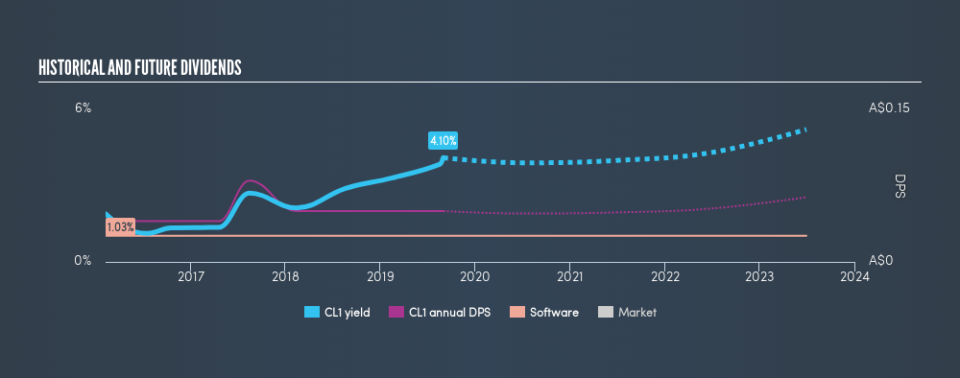Just 3 Days Before Class Limited (ASX:CL1) Will Be Trading Ex-Dividend

Class Limited (ASX:CL1) is about to trade ex-dividend in the next 3 days. You will need to purchase shares before the 5th of September to receive the dividend, which will be paid on the 27th of September.
Class's next dividend payment will be AU$0.025 per share. Last year, in total, the company distributed AU$0.05 to shareholders. Calculating the last year's worth of payments shows that Class has a trailing yield of 4.1% on the current share price of A$1.22. If you buy this business for its dividend, you should have an idea of whether Class's dividend is reliable and sustainable. That's why we should always check whether the dividend payments appear sustainable, and if the company is growing.
Check out our latest analysis for Class
Dividends are typically paid from company earnings. If a company pays more in dividends than it earned in profit, then the dividend could be unsustainable. Class paid out 65% of its earnings to investors last year, a normal payout level for most businesses. Yet cash flows are even more important than profits for assessing a dividend, so we need to see if the company generated enough cash to pay its distribution. It paid out 99% of its free cash flow in the form of dividends last year, which is outside the comfort zone for most businesses. Companies usually need cash more than they need earnings - expenses don't pay themselves - so it's not great to see it paying out so much of its cash flow.
Class paid out less in dividends than it reported in profits, but unfortunately it didn't generate enough cash to cover the dividend. Cash is king, as they say, and were Class to repeatedly pay dividends that aren't well covered by cashflow, we would consider this a warning sign.
Click here to see the company's payout ratio, plus analyst estimates of its future dividends.
Have Earnings And Dividends Been Growing?
Stocks in companies that generate sustainable earnings growth often make the best dividend prospects, as it is easier to lift the dividend when earnings are rising. If earnings decline and the company is forced to cut its dividend, investors could watch the value of their investment go up in smoke. Fortunately for readers, Class's earnings per share have been growing at 18% a year for the past five years. Earnings have been growing at a decent rate, but we're concerned dividend payments consumed most of the company's cash flow over the past year.
The main way most investors will assess a company's dividend prospects is by checking the historical rate of dividend growth. Class has delivered an average of 5.7% per year annual increase in its dividend, based on the past 4 years of dividend payments. Earnings per share have been growing much quicker than dividends, potentially because Class is keeping back more of its profits to grow the business.
Final Takeaway
Is Class worth buying for its dividend? The best dividend stocks typically boast a long history of growing earnings per share (EPS) via a combination of earnings growth and buybacks. So, you might think that Class buying back stock, growing its EPS, and retaining profits within its business is a good combination. However, we note with some concern that it paid out 99% of its free cash flow last year, which is uncomfortably high and makes us wonder why the company chose to spend even more cash on buybacks. Overall, it's hard to get excited about Class from a dividend perspective.
Curious what other investors think of Class? See what analysts are forecasting, with this visualisation of its historical and future estimated earnings and cash flow .
If you're in the market for dividend stocks, we recommend checking our list of top dividend stocks with a greater than 2% yield and an upcoming dividend.
We aim to bring you long-term focused research analysis driven by fundamental data. Note that our analysis may not factor in the latest price-sensitive company announcements or qualitative material.
If you spot an error that warrants correction, please contact the editor at editorial-team@simplywallst.com. This article by Simply Wall St is general in nature. It does not constitute a recommendation to buy or sell any stock, and does not take account of your objectives, or your financial situation. Simply Wall St has no position in the stocks mentioned. Thank you for reading.

